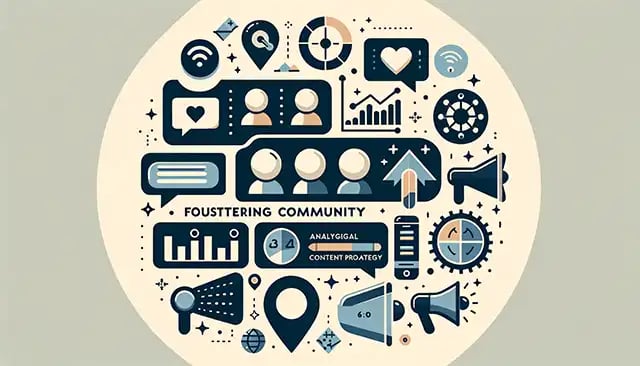Smart Strategies: Social Media for Business Success
- Home
- Smart Strategies: Social Media for Business Success
your business is a buzzing hive, and social media for business is the honey that keeps it thriving. Now imagine reaching into that hive and pulling out fistfuls of golden opportunities, each one ready to transform how you connect with customers. That's what tapping into the power of social media can do.
Gone are the days when social platforms were just digital hangouts; they're now potent tools in any company’s arsenal, driving real-time interaction and networking like never before. By diving in today, you'll uncover strategies to engage directly with users on Twitter or Facebook—think immediate feedback loops sparking vibrant conversations. And there's more brewing over at LinkedIn where B2B networking isn't just growing—it's flourishing. Ready to get started? Let’s peel back the layers together.
Table Of Contents:
- The Role of Social Media Platforms in Business Communication and Networking
- Advantages of Social Media Marketing for B2B Companies
- Advantages of Social Media Marketing for B2B Companies
- Navigating the UK's B2B Social Media Landscape
- Crafting a Robust Social Media Strategy Template
- FAQs about Social Media for Business
- Conclusion

The Role of Social Media Platforms in Business Communication and Networking
Imagine social media as a bustling town square where businesses set up shop to talk directly with passersby—that's the kind of real-time interaction platforms like Twitter and Facebook offer. It's not just about posting updates; it's an open line for immediate customer feedback and engagement, revolutionizing how companies connect with their audience.
Real-Time Customer Engagement
Twitter is your go-to digital megaphone, allowing you to broadcast messages that resonate far beyond traditional borders. Whether it’s breaking news or customer service inquiries, this platform gives voice to brand narratives at lightning speed. But let’s not overlook Facebook—the global giant boasts a user base hungry for content that tells a story or solves their problems on the spot.
Social presence on these platforms isn't merely about showing up it's also about maintaining a social media presence and social listening; it involves crafting conversations that reflect your business ethos while also catering to what tickles your target audience’s fancy. Remember when one tweet from a consumer turned into a heartwarming tale of exceptional customer service? Such stories underscore why maintaining an active social network can turn casual browsers into loyal customers.
Building Online Networks
Moving over to LinkedIn another great B2B social media tool—think of it as the corporate cocktail party where deals are struck over digital handshakes. Here lies fertile ground for B2B networking, giving professionals space to grow roots within industry circles through shared insights and opportunities.
A vibrant LinkedIn profile does more than list accomplishments—it ignites discussions, cements thought leadership status, and even fosters partnerships across continents. With its tailored approach suited for professional connections among business social media users in various industries—including those navigating the UK market—it offers much more than mere connectivity; it provides pathways towards meaningful collaborations.
Advantages of Social Media Marketing for B2B Companies
Beneath every successful B2B venture, today is likely a savvy marketer who has leveraged a social media marketing strategy smart enough to boost visibility exponentially without yelling from rooftops (or spamming feeds).
Enhanced Brand Visibility on Social Platforms
Picture Instagram—a canvas waiting for visual storytelling magic that turns brands into icons overnight. A strategically placed image here leads followers down memory lane or showcases innovation sparking increased brand awareness without saying too much—or anything at all.
Social media management solutions come in handy when plotting out such intricate displays, ensuring each post aligns perfectly with broader business strategies.
Lead Generation Through Targeted Campaigns
Targeted campaigns on LinkedIn harness data-driven precision akin only perhaps to cupid arrows finding marks amid crowded rooms full of potential clients—all aimed squarely at generating quality leads ready to be engaged with monthly active posts. By tapping into this platform's rich datasets and advanced targeting capabilities, businesses can connect with prospects in a way that's both efficient and highly personalized.
Think of social media as a lively town square for real-time chats with customers, making your brand more human and approachable.
Use Twitter to share fast updates and Facebook to tell stories that hit home. LinkedIn? That's where you make professional friends and spark meaningful collaborations.
On Instagram, let visuals do the talking to boost your brand. Remember, targeted campaigns on platforms like LinkedIn can be gold mines for lead gen.

Advantages of Social Media Marketing for B2B Companies
Social media marketing isn't just a buzzword; it's a pivotal gear in the machinery of modern B2B business strategies. It transcends mere posts, video content and likes to become a powerhouse for brand visibility and lead generation.
Enhanced Brand Visibility on Social Platforms
Social media offers a vibrant stage where brands can showcase their stories through compelling visuals. On platforms like Instagram, it's not about the loudest voice but about crafting narratives that deeply engage and resonate with your audience. Here, social media provides the tools to create an engaging, sensory-rich experience, elevating your brand's visibility. Evaluate your approach: are you simply adding to the noise, or are you leveraging what social media provide, to weave unique, memorable stories that make your brand stand out? Success in this digital landscape hinges on mastering the art of visual storytelling.
Lead Generation Through Targeted Campaigns
If there's one thing more satisfying than connections on LinkedIn, it’s converting those connections into high-quality leads. This is where savvy social media strategy templates come into play—guiding you through crafting campaigns tailored to resonate with your target audience.
Delving deeper using analytics tools could give insights previously untapped by standard market research methods. Imagine knowing exactly what piques the interest of professionals who make up your potential customers—it’s like having X-ray vision but better because data doesn’t lie.
Navigating the UK's B2B Social Media Landscape
you're at a bustling digital crossroads where business deals are struck with likes, shares, and strategic hashtags. Welcome to the dynamic world of the UK's B2B social media market. With its distinct flavour and unspoken rules, it beckons companies to tap into its potential.
LinkedIn's Dominance in Professional Networking
The stage is set with LinkedIn as the lead actor in professional networking within the UK. This isn't just idle chatter; we're talking about a platform where serious connections are made every day. Here businesses don't just meet but engage deeply thanks to LinkedIn’s robust user base tailored for career-focused professionals.
If you aim to forge solid relationships that transcend mere transactions, think of LinkedIn as your go-to wingman in these endeavours. The numbers sing praises too – it stands tall as a top pick among professional circles seeking quality over quantity when connecting across industry lines.
To truly leverage what LinkedIn offers businesses consider this: It gives you direct access to thought leaders and decision-makers who could be instrumental in steering your company towards greener pastures—figuratively speaking.
Real-Time Customer Engagement
Dive into Twitter or Facebook if real-time interaction strikes a chord with you because here speed matters—as does wit. Imagine being able to respond instantly to customer feedback or trending topics relevant to your sector; now picture doing so while adding personality through carefully crafted posts that reflect your brand voice—it’s all possible on these platforms.
Tweets can fly fast but remember they also land directly onto screens of potential customers keen on staying updated minute-by-minute—a goldmine for savvy marketers aiming for immediate impact.
Building Online Networks
Away from the hustle-bustle lies another side of social media—the one that builds bridges between like-minded enterprises through more subdued yet powerful networks beyond LinkedIn alone. Niche forums and specialized groups found across various platforms serve as congregation spots brimming with collaborative spirit amidst focused discussions ripe for insight sharing—and trust me, there’s always room at these tables for new participants eager to learn from peers while offering their unique perspectives.
Enhanced Brand Visibility on Social Platforms
In the dynamic world of digital media, platforms like Instagram are vital for storytelling and are a way to increase brand awareness. Here, your brand's visibility hinges on crafting engaging visual stories that resonate with your audience, rather than sheer volume. It's about creating an immersive experience with each post, connecting emotionally and capturing interest. Assess your strategy: Are you merely adding to the digital noise, or are you weaving memorable narratives that make your brand stand out? Success in social media lies in the art of visual storytelling that speaks directly to your audience's senses.
Lead Generation Through Targeted Campaigns
- With precision cutting techniques, we're not just slicing through materials; we're carving out efficiency and quality in every project. Let our expert team transform your concepts into reality with unmatched skill.
LinkedIn shines in the UK's B2B scene as a hub for making meaningful connections. Twitter and Facebook are key for real-time engagement, while niche forums build collaborative networks. Instagram tells your brand's story visually, capturing attention without noise.

Fostering Community Through Interaction
Building a strong community on social media requires active engagement and interaction. Respond to comments, messages, and mentions promptly to show your audience that you value their input. Encourage discussions and conversations by asking questions or running polls. By fostering a sense of community, you can create loyal fans who will advocate for your brand.
Analyzing Results and Tweaking Accordingly
Don't just set it and forget it. Use social media analytics tools to regularly analyse the results of your social media efforts and blog posts to see what's working and what's not. Use analytics tools to track metrics such as engagement, reach, and conversions. Based on these insights, make adjustments to your strategy to optimize your results. Remember, it's a continuous learning process.
Promoting Engaging Content Strategically
Every piece of content you share on social media should be engaging and strategic. It should tell a part of your brand's story and encourage action from your audience. Whether it's a tweet, a pin, or a video, make sure it ties back to your larger narrative. By threading your content together seamlessly, you can keep your viewers invested and curious to see what unfolds next.
To promote effectively, sprinkle calls-to-action strategically throughout your content. Encourage your audience to share, like, and join the conversation. By building a stronger community, you can rally people behind your mission and vision, ultimately growing your brand.
Crafting a Robust Social Media Strategy Template
Your small business is like a beehive, buzzing with potential customers. Now, how do you get these busy bees to swoop in and savour your honey? That's where an ironclad social media strategy template comes into play to generate leads and provide insights.
Identifying Goals and Target Audience
Your first step is to define what success looks like for your brand on social platforms. Is it more followers or deeper engagement? Once that's clear, zero in on who you're talking to. Picture the ideal customer scrolling through their feed – what are they liking, sharing, and engaging with?
Digging into analytics tools can give insights into user behaviours and preferences of active users—this intel informs content creation that resonates deeply with your audience.
Choosing the Right Platforms
You wouldn't wear flip-flops to a snowball fight, right? So why would you pick just any platform without seeing if it fits your brand style and goals? For instance, LinkedIn shines bright for B2B connections while Instagram could increase brand visibility through captivating visuals. Both can drive traffic to your site.
When choosing the right media market for your needs, think about who you want to reach, how they consume content and how they share content. Do some digging into demographics and viewing habits to find where your audience hangs out. Look at what's trending, but also consider evergreen platforms that consistently perform well over time.
To get started, list down your goals and target audience. Then match those with potential markets by checking ratings and engagement levels on different platforms. Remember, it’s not just about being everywhere—it's about being where it counts for your specific audience.
If you’re still unsure which direction to take, consult with a media planning expert who can conduct market research or use analytics tools for deeper insights into monthly active users, industry trends, competitor analysis and consumer behaviour patterns. They can give you the data-driven scoop on what works best in each market.
Build a tight-knit community on social media by quickly responding to comments and sparking conversations. Keep your content strategy fresh by regularly checking analytics and adjusting tactics. Make every post count, with engaging stories that urge followers to act.
Develop a killer social media plan by defining clear goals and knowing who you're chatting with. Choose platforms like you'd pick the right shoes for an outfit—go where it makes sense for your brand's style and audience.
FAQs about Social Media for Business
Which social media is best for business?
The right platform varies by your audience and goals. LinkedIn shines for B2B, while Instagram and Facebook are key for direct consumer engagement.
What is social media good for in business?
Social media boosts brand exposure, fosters customer relationships, provides market insights, and drives traffic to your site.
How can I use social media for my business?
Create consistent content that aligns with your brand voice. Engage actively with followers and analyze data to refine strategies.
What social media platform do small businesses use most?
Small businesses often start with Facebook or Instagram due to their large user bases and varied advertising tools.
Conclusion
Master social media for business, and you master the art of conversation. Embrace platforms like Twitter and Facebook to spark real-time dialogues with your audience.
Leverage LinkedIn's networking power; it's where B2B connections flourish. Understand this: strong visual content on Instagram can skyrocket brand visibility.
Remember, targeted campaigns are key—use them to turn professional interactions into high-quality leads. Strategy is king in the UK's diverse digital terrain, so craft a robust template that adapts across all channels.
Your takeaway? Engage fast, network smartly, personalize strategically—and watch as every tweet and post turns into potential growth for your hive of activity.


